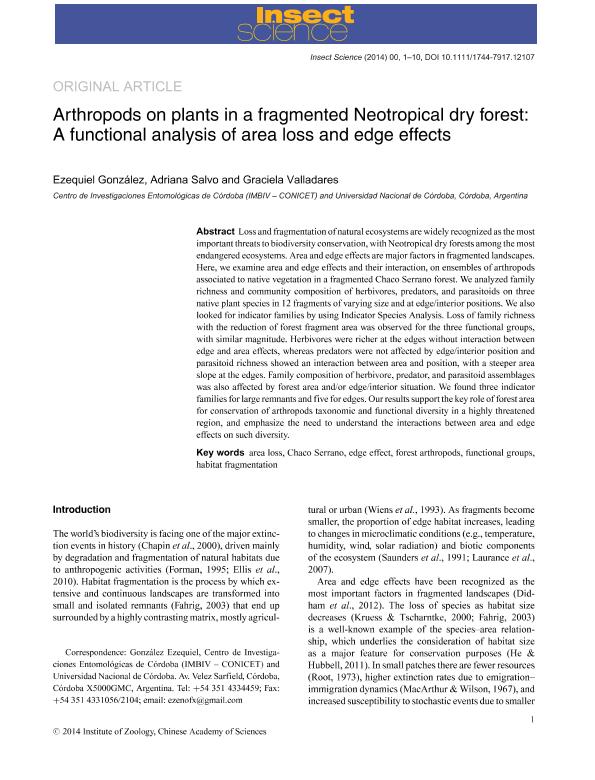Mostrar el registro sencillo del ítem
dc.contributor.author
González, Ezequiel

dc.contributor.author
Salvo, Adriana
dc.contributor.author
Valladares, Graciela Rosa

dc.date.available
2016-12-19T19:51:06Z
dc.date.issued
2014-03
dc.identifier.citation
González, Ezequiel; Salvo, Adriana; Valladares, Graciela Rosa; Arthropods on plants in a fragmented Neotropical dry forest: a functional analysis of habitat loss and edge effects; Wiley; Insect Science; 22; 1; 3-2014; 129-138
dc.identifier.issn
1672-9609
dc.identifier.uri
http://hdl.handle.net/11336/9771
dc.description.abstract
Loss and fragmentation of natural ecosystems are widely recognized as the most important threats to biodiversity conservation, with Neotropical dry forests among the most endangered ecosystems. Area and edge effects are major factors in fragmented landscapes. Here, we examine area and edge effects and their interaction, on ensembles of insects associated to native vegetation in a fragmented Chaco Serrano forest. We analyzed family richness and community composition of herbivores, predators and parasitoids on three native plant species in 12 fragments of varying size and at edge/interior positions. We also looked for indicator families by using Indicator Species Analysis. Loss of richness with the loss of forest area was observed for the three functional groups, with similar magnitude. Herbivores were richer at the edges without interaction between edge and area effects, whereas predators were not affected by edge/interior position and parasitoid richness showed an interaction between area and position, with a steeper area slope at the edges. Composition of herbivore, predator and parasitoid assemblages was also affected by forest area and/or edge/interior situation. We found three indicator families for large remnants and five for edges. Our results support the key role of forest area for conservation of insect taxonomic and functional diversity in a highly threatened region, and emphasize the need to understand the interactions between area and edge effects on such diversity.
dc.format
application/pdf
dc.language.iso
eng
dc.publisher
Wiley

dc.rights
info:eu-repo/semantics/openAccess
dc.rights.uri
https://creativecommons.org/licenses/by-nc-sa/2.5/ar/
dc.subject
Area Loss
dc.subject
Forest Arthropds
dc.subject
Edge Effect
dc.subject
Functional Group
dc.subject
Chaco Serrano
dc.subject
Habitat Fragmentation
dc.subject.classification
Ecología

dc.subject.classification
Ciencias Biológicas

dc.subject.classification
CIENCIAS NATURALES Y EXACTAS

dc.title
Arthropods on plants in a fragmented Neotropical dry forest: a functional analysis of habitat loss and edge effects
dc.type
info:eu-repo/semantics/article
dc.type
info:ar-repo/semantics/artículo
dc.type
info:eu-repo/semantics/publishedVersion
dc.date.updated
2016-12-12T14:18:22Z
dc.journal.volume
22
dc.journal.number
1
dc.journal.pagination
129-138
dc.journal.pais
Reino Unido

dc.journal.ciudad
Londres
dc.description.fil
Fil: González, Ezequiel. Consejo Nacional de Investigaciones Científicas y Técnicas. Centro Científico Tecnológico Córdoba. Instituto Multidisciplinario de Biología Vegetal (p); Argentina. Universidad Nacional de Córdoba; Argentina
dc.description.fil
Fil: Salvo, Adriana. Universidad Nacional de Córdoba; Argentina. Consejo Nacional de Investigaciones Científicas y Técnicas. Centro Científico Tecnológico Córdoba. Instituto Multidisciplinario de Biología Vegetal (p); Argentina
dc.description.fil
Fil: Valladares, Graciela Rosa. Consejo Nacional de Investigaciones Científicas y Técnicas. Centro Científico Tecnológico Córdoba. Instituto Multidisciplinario de Biología Vegetal (p); Argentina
dc.journal.title
Insect Science

dc.relation.alternativeid
info:eu-repo/semantics/altIdentifier/url/http://onlinelibrary.wiley.com/doi/10.1111/1744-7917.12107/abstract
dc.relation.alternativeid
info:eu-repo/semantics/altIdentifier/doi/http://dx.doi.org/10.1111/1744-7917.12107
Archivos asociados
